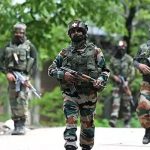China’s Foreign Minister Wang Yi’s visit to India on 18 August 2025 marks a critical juncture in the evolution of India–China relations. While the move is being widely interpreted as a sign of normalisation after years of crisis and mistrust, the reality is far more nuanced. Beneath gestures of thaw and renewed engagement, deeply embedded structural issues and divergent strategic objectives persists, limiting the prospects for a genuine reconciliation.
The Line of Actual Control: From De-escalation to Persistent Ambiguity
After the 2020 Galwan Valley clashes shattered diplomatic normalcy and led to a military standoff lasting several years, the October 2024 agreement brokered disengagement at key friction points like Demchok and Depsang. This enabled the resumption of patrols and prompted the resumption of Special Representatives (SR) talks in December 2024.
Yet, military deployments along the LAC continue, with tens of thousands of troops and substantial infrastructure remaining on both sides. Despite disengagement in select areas and ending of standoffs at Depsang and Demchok, de-escalation is yet to take place. Additionally, differences in the perception of the LAC still persist across all sectors signaling that the boundary issue is far from settled.
Security Risks Amidst Normalisation
India faces a critical question: Can the normalisation process move forward while both countries retain robust defensive postures along the border? The resumption of dialogue and confidence-building steps, such as reopening visa channels and pilgrimage routes may reduce the risk of immediate conflict, but the absence of a hard border settlement means future incidents cannot be ruled out. Moreover, the infrastructure buildup, including dual-use facilities and China’s gray-zone operations, continues to complicate the security landscape.
Diplomatic Engagements: Progress or Tactical Pause?
Wang Yi’s Delhi visit and upcoming meetings with Indian leaders including the National Security Advisor are being seen as attempts to consolidate the fragile calm. While both sides are discussing to resume border trade and are restarting direct flights, these represent incremental steps rather than a diplomatic breakthrough. India remains firm: normalisation in other spheres cannot proceed without demonstrable progress on border issues.
China’s Broader Strategic Objectives
China’s engagement is shaped by its desire to stabilise ties to present itself as a responsible regional actor amid rising U.S. tariffs and shifting global alignments. Beyond the border, Beijing seeks to limit India’s strategic space, expanding its presence in South Asia, the Indian Ocean, and around India’s periphery via economic and military investments. The Belt and Road Initiative and growing defence partnerships with India’s neighbors underscore China’s intent to encircle India and dilute its regional influence.
China’s approach to the border issue is also tactical: by offering temporary calm, Beijing hopes to divert India’s attention from contentious moves elsewhere, seek concessions in economic domains, and posture as a champion of ‘Global South Solidarity’, aiming to stabilise the region while retaining leverage on the boundary.
Indian Foreign Policy: Strategic Autonomy and Cautious Engagement
India’s response is shaped by a doctrine of “Strategic Autonomy”: co-operate with China when practical, but push back where interests diverge. While resuming talks provides breathing room for bilateral discussions, New Delhi should not see these moves as signals of genuine transformation. Instead, it should resolve to continue investing in border infrastructure, diversify supply chains, and deepen relations with other powers, especially as U.S. tariffs bite and old alignments shift.
At the regional level, India’s competitive engagement with China is evident in Southeast Asia and the Indian Ocean Region, with both powers vying for primacy and influence. India’s recent outreach to ASEAN, efforts to lead multilateral forums, and protectionist practices are direct responses to China’s asymmetric, and proactive regional statecraft.
Economic Interdependence vs. Strategic Mistrust
The opening of trade and people-to-people exchanges, such as the resumption of border trade and flights highlights the pragmatic dimension of the relationship. However, the trajectory of economic ties remains overshadowed by strategic mistrust. Key trade channels, such as rare earth imports and fertilizers, remain subject to sudden restrictions, while competition in technology and investment remains intense.
India should seek to benefit from diversification and changing global supply chain patterns, but must be wary of over-dependence on Chinese imports, particularly in critical sectors. The technological rivalry, compounded by cyber threats, means economic cooperation is always circumscribed by security calculations.
The Next Five Years: Conditional Coexistence
While Wang Yi’s visit reflects cautious optimism and potential for incremental progress, the pattern remains one of gradual confidence-building rather than radical breakthroughs. The durability of the current thaw hinges on substantive security reforms, sustained diplomatic mechanisms, and effective management of external pressures, from U.S.-China competition to regional groupings.
If one factor is to decide the direction of India–China relations, it will be the management of border mechanisms, whether they can move from tactical pauses to durable frameworks for dispute resolution. External influences, especially shifts in U.S. and Russian strategies, will further complicate the landscape, ensuring that Asia’s two largest powers continue to oscillate between cooperation, coexistence, and contestation.
Conclusion
In sum, the process of normalisation between India and China is underway, but it is fragile, partial, and contingent on the resolution of deep-rooted disputes along the LAC. Core issues (border dispute, access to Chinese market, access to technology and critical minerals etc), remain unresolved, and larger strategic competition persists across South Asia, maritime domains, and multilateral forums. Economic, diplomatic, and people-to-people initiatives, while significant, cannot by themselves override mistrust rooted in historical experience and competing ambitions. The handshake may have replaced the standoff, but it is an uneasy grip, and the future will be shaped by conditional coexistence rather than genuine confidence or comprehensive reconciliation.
Discalimer: This article builds upon and continues the discussion initiated in the podcast titled “From Standoff to Handshake: What Wang Yi’s India Visit Really Means?” streamed on Strategic Frontlines (YouTube), CLAWS, on August 14, 2025. The authors acknowledge that insights shared by the guest speaker, Dr Sriparna Pathak, during the podcast were instrumental in motivating further analysis of Wang Yi’s visit to India.














Awesome have great input and insights that related to future prospects
Very nice article Ashu! Keep it up!